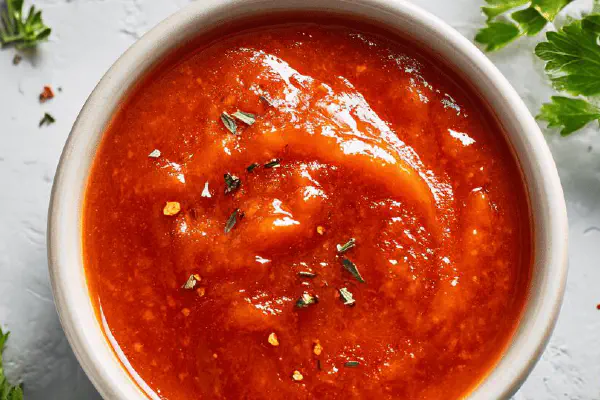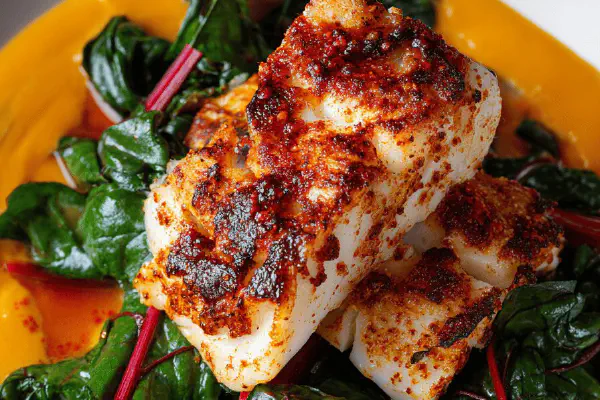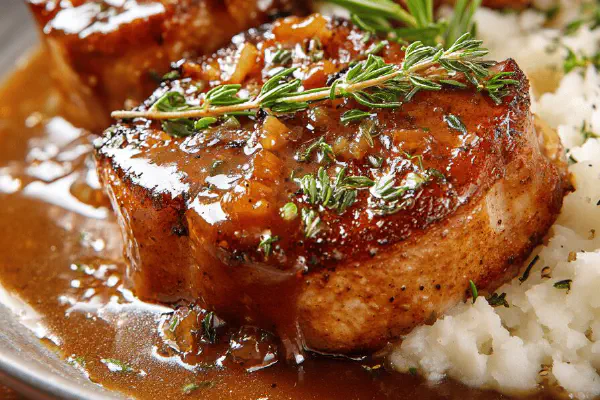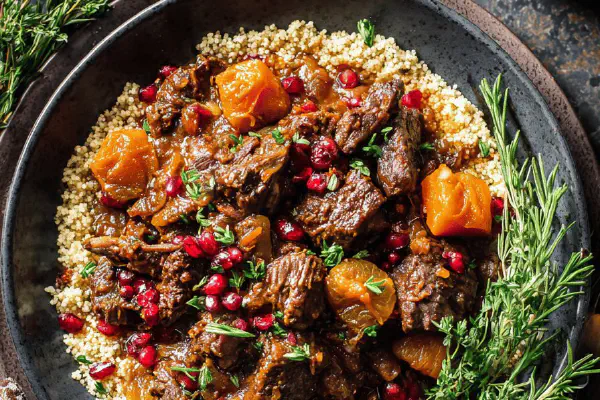Veal Medallions With Fresh Tomatoes
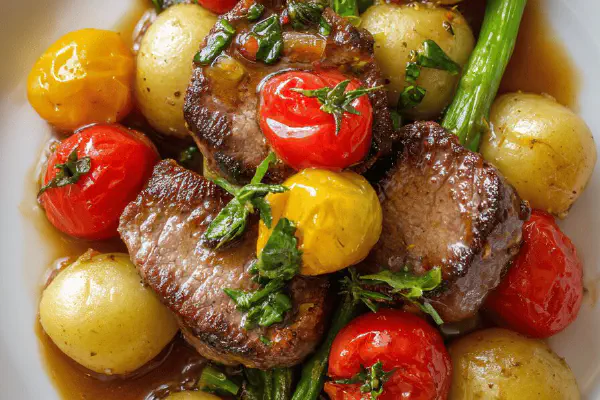
By Emma
Certified Culinary Professional
Ingredients
- 30 small green asparagus, trimmed and halved
- 2 tbsp extra virgin olive oil
- 150 ml finely sliced shallots
- 3 garlic cloves, minced
- 3 tbsp olive oil
- 100 ml dry white wine
- 150 ml beef broth, preferably low sodium
- 500 g veal medallions, sliced from tenderloin
- 5 baby Yukon gold potatoes, boiled and halved
- 4 red tomato slices at room temperature
- 4 yellow tomato slices at room temperature
- 1/4 cup freshly chopped basil leaves
- 1 tbsp fresh thyme leaves
- Salt and cracked black pepper to taste
- Zest of 1 lemon
About the ingredients
Method
- Preheat oven to broil, rack in upper third of oven.
- Spread asparagus on rimmed baking sheet; drizzle with 1 tbsp olive oil, season with salt and pepper. Roast until spears are barely tender, 7 to 8 minutes. Toss halfway through for even roasting.
- Heat 2 tbsp olive oil in skillet over medium heat. Add shallots and garlic. Sauté gently for 3 to 4 minutes until translucent and fragrant; do not brown.
- Pour white wine into pan, increase heat slightly and reduce by half until sauce thickens and smells sharp but mellow. Add beef broth and simmer for 3 minutes to meld flavors. Stir in lemon zest and thyme leaves at this point. Remove sauce to separate bowl, reserve.
- In same skillet, add splash more olive oil if dry. Pat veal medallions dry, season well with salt and pepper. Sear on each side 2 to 3 minutes until browned and center still pink; avoid overcooking or veal toughens. Transfer medallions to warm plate tented with foil.
- Add prepared sauce back to skillet, scraping up any browned bits stuck to pan bottom. Adjust seasoning with salt and pepper.
- Add baby potatoes and roasted asparagus to skillet to warm through gently, stirring to coat with sauce for 2 minutes. Keep veggies firm, avoid mushiness.
- Arrange plates: layer tomato slices alternately red and yellow, sprinkle with fresh basil.
- Pile asparagus and potatoes over tomatoes, then top medallions on vegetables. Spoon warm sauce over meat and around plate.
- Serve immediately. If you lack fresh asparagus, substitute with tender green beans or broccolini, roast similarly. Lemon zest brightens and replaces classic tarragon Akvavit note, adding charm.
- When cooking veal, avoid crowding pan to ensure nice sear; crowded pan steams meat and flakes flavor away.
- Use high heat for searing but watch carefully—veal cooks fast and is prone to drying out.
- Keeping potatoes simmered just till fork tender but firm helps maintain texture when reheated in sauce.
- If sauce gets too thin, a quick whisk of cold butter cubes off-heat adds luscious body without cream.
- Roasting asparagus on a single layer encourages caramelization, boosting natural sweetness.
- Fresh tomatoes at room temperature provide juiciness and acidity that cookout tomatoes lack.
- Adding thyme gives earthiness and complexity, balancing lemon's brightness and wine's acidity.
- To quickly peel shallots if needed, blanch in boiling water 15 seconds then shock in ice water; skins slip right off.
- Use dry white wine like Sauvignon Blanc or Chardonnay; avoid sweet varieties that will jar sauce balance.
- Reserve any extra sauce for drizzling over veggies or breakfast eggs next day.
- Remember to rest veal 2 minutes before plating to allow juices to settle.
- Finishing sauce in hot pan deglazes fond and enhances dimensional flavor—never pour sauce cold onto meat.
- If in rush, asparagus can be steamed but roasting adds caramelized notes I find essential.
Cooking tips
Chef's notes
- 💡 Sear the veal on high heat but watch closely; sizzling sound stops suddenly when meat starts cooking through—don’t crowd pan or you’ll get steamed edges, losing crust and texture. Dry patting medallions before seasoning is must—moisture kills sear. Rest 2 minutes after cooking—juices redistribute, stops leak-out on plate.
- 💡 Roast asparagus single layer on rimmed sheet; tossing once halfway helps even roasting. Timing is tight—7-8 minutes usually. Should give slightly under gentle pressure but still snap crisp. Overroasted turns soft fast and loses sweetness. Toss with oil before oven, salt after for best result.
- 💡 For sauce, start gently sautéing shallots and garlic low and slow until translucent and fragrant. Browning here means bitterness later. Reduction of white wine and broth thickens well; too far and acidity overpowers, sniff carefully as it bubbles down. Lemon zest and thyme added late preserve brightness, avoid cooking aromatic oils off.
- 💡 Potatoes boiled just till fork-tender but firm hold better in sauce reheating. Yukon gold are my go-to over grelots; texture stays creamier without becoming mealy. Toss warmed veggies off heat gently in sauce to prevent mashiness. If sauce too thin at finish, whisk cold butter cubes in off heat adds body without cream or flour thickener.
- 💡 Tomatoes at room temperature retain juiciness and acidity that cold ones lack. Layer alternating red and yellow slices for look and taste contrast. Sprinkle fresh basil on top last. Fresh thyme in sauce adds earthiness and complexity balancing citrus zing. If lacking thyme, oregano works but shifts flavor profile slightly.
Common questions
How to tell veal doneness?
Pink inside is key but not raw. Use timing—2-3 minutes each side on medallions about 1 inch thick. Look for browned crust, avoid drying out. Meat should bounce back slightly when poked. Overcooking makes tough. Rest after sear for juices to settle.
Substitutes for asparagus?
Tender green beans or broccolini work well roasted similarly. Both have crispness when roasted briefly. Avoid woody stalk versions, parboil if unsure. Steaming ok in rush but missing caramelized notes. Olive oil and salt still needed for flavor lift.
What if sauce turns too thin?
Whisking cold butter off the heat thickens quickly. Avoid heavy cream or flour roux here for brightness preservation. Reduce longer if time allows but watch to not overpower acid. Add salt pepper last to adjust since reduction concentrates flavors unevenly.
Can leftovers be stored?
Yes but veggies separate from meat best. Medallions rest covered and chilled, reheat gently to avoid drying out. Sauce thickens in fridge; loosen with splash beef broth or water when reheating. Potatoes hold texture better boiled firmer, avoid mush on reheat by warming slow.
